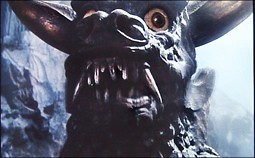
Tempo
Stockholm
STOCKHOLM 12 March 2010 at 10.30-20
Documentaries on and by artists
For many years now, video art has had a close affinity to documentarism, an aspect that Moderna Museet and the Tempo Documentary Festival want to acknowledge by jointly presenting art videos/documentaries by artists exploring sociological phenomena relating to a globalised world.
Three artists will be featured in two artist portraits: Latvian photographer Inta Ruka, South African painter Marlene Dumas, who lives and works in Amsterdam, and South African animator William Kentridge.
Magnus Bärtås and Cecilia Parsberg will be present to introduce their films and participate in the discussion in the Studio afterwards on crossroads in artistic projects incorporating documentary material.
Discussion moderator: Catrin Lundqvist, Moderna Museet.
SESSION 1: 10.30 – 13.05
10.30 Introduction
10.40
Kumiko, Johnnie Walker & The Cute
Magnus Bärtås
SWEDEN, 2006–2007
50 min, HD/VIDEO
This video essay, filmed in Tokyo and Paris, is based on the primordial concept of the impending loss of self. It is about Kumiko Muraoka, the main character in Chris Marker’s film The Koumiko Mystery, and Johnnie Walker, a fictional character in a novel by Haruki Murakami. Johnnie Walker, a Japanese homosexual Jew, is regarded by the people around him as a foreigner even though his family have been Japanese citizens for many generations. Johnny Walker has chosen the path of confrontation and provocation. With his Irish wolfhound he challenges the Japanese “cuteness” cult and its admiration for the neo-liberal concept of Soft Power.
11.30
Madam & Little Boy
Magnus Bärtås
SWEDEN, 2009
27 min, HD/VIDEO
Swedish première!
In 1978, the legendary South Korean actress Choi Eun-Hee (Madam Choi) was kidnapped in Hong Kong by North Korean agents. She was taken to Pyongyang, just like her ex-husband, the film director Shin Sang-Ok. This video essay examines the historical and repetitive traits of Choi Eun-Hee’s life. Godzilla the Monster’s genealogy, via Pulgasari, to Galgameth (Shin’s remake of Pulgasari in Hollywood), are interpreted as straight-forward messages about nuclear weapons. The video takes a stand against conventional documentary practice in an experiment with “situated storytelling”, which entails that the narrator is visible and tied to a specific place.
12.10-12.15 SHORT BREAK
12.15
A Heart from Jenin
Cecilia Parsberg
SWEDEN, 2007
45 min, DVD
This is the story of Ahmed’s heart. Ahmed was a Palestinian boy who lived in the refugee camp in Jenin on the West Bank. When he was 12, in November 2005, he was killed by an Israeli sniper. His parents decided to donate their son’s heart to an Israeli girl. The film is also about this girl, Samah, who is now alive thanks to Ahmed’s heart. For Ahmed’s parents, their son lives on in the girl, as an expression of the hope for peace with Israel. Thus, it is possible to drill holes in dividing walls, if there is someone on the other side who wants to receive one’s gift. For more information, visit www.this.is/parsberg
13.10-13.30 BREAK
Session 2: 13.30-17.30
13.30-14.45
Kentridge and Dumas in Conversation
Catherine Meyburg
SOUTH AFRICA, 2009
74 min, DIGIBETA
Swedish première!
South African artists William Kentridge and Marlene Dumas discuss the conditions for artists, in an open-hearted look at similarities and differences in their oeuvres, sources of inspiration and audience reception. And the courage that is needed; how does one paint desire and sexuality without it turning into pornography? How can we relate to painful memories? Both Kentridge and Dumas comment on the times, albeit in different ways – Dumas mainly in her oil paintings, Kentridge in his exceedingly detailed animations. This documentary was filmed in the artists’ studios in South Africa and Amsterdam, where Marlene Dumas has lived since the 1970s.
14.45-14.50 SHORT BREAK
14.50
Alby dharma
Sonia Hedstrand
SWEDEN, 2009
19 min, HD/Video
On the sixth floor of a high-rise building in the 1960s Alby housing estate, there is a Buddhist temple. Several monks from Asia used to live and work here, but it was dark and cold, the landlord complained, and it was too depressing having to wear thick jackets and shoes. Only Bhante Pannaratana stayed on in the grey, cold suburb, keeping up the temple activities even though most of the people living in this area are Moslems or Christians, and his holy Bhodi tree from Sri Lanka is about to perish due to lack of sunlight.
15.10-16.15
The photographer from Riga
Maud Nycander
SWEDEN, 2009
55 min, DV-CAM
Inta Ruka became internationally famous when her photos where exhibited at the Venice Biennale in 2005. Despite this, she still works as a cleaner at the Swedish Embassy in Riga. As a personal friend of the Latvian photographer, Maud Nycander compares their two lives and looks at how the iron curtain impacted on their respective artistic oeuvres.
16.20
My Beautiful Dacia
Stefan Constantinescu and Julio Soto
SWEDEN/SPAIN, 2009
55 min, HD/Video
Swedish première!
A humorous essay on the Romanian odyssey from communism to capitalism, taking one of Romania’s most charismatic symbols as its starting-point – a Dacia. The film chronicles several Romanians, whose lives are interwoven by the modest car, and who reflect on the ongoing transformation of Romanian society. Perhaps the story of the Dacia reflects the social changes in Romania?
17.30
DISCUSSION ABOUT CROSSROADS + BAR IN THE STUDIO – Admission free!
On crossroads in artistic projects with documentary material.
With: Magnus Bärtås and Cecilia Parsberg. Language: Swedish.
Moderator: Catrin Lundqvist, Moderna Museet
The Studio event organisers will also be showing works by the artist Jon Brunberg, Stockholm. Bar and free admission!
